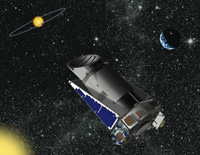Kepler Boggles Imagination of Astronomers
About 3,300 astronomers and students are in Washington for the annual winter meeting of the American Astronomical Society, where sessions range from why stars explode to how astronomers can find a job. The gathering's first day was dominated by news from Kepler, a new space telescope NASA launched in March on a mission to find Earth-like planets.

The very early results are tantalizing. Astronomers said they found five new planets, all much bigger than Earth. An additional 100 or so signals are being analyzed that might indicate planets. The new telescope has also revealed that the sun is not anomalously calm by galactic standards, which boosts the odds that other solar systems would be habitable.
A race is going on between American and European scientists to find the first "Earth" -- a planet that is about its size and simultaneously in the "habitable zone" of a star. In the habitable zone, a planet would be in the Goldilocks position, neither too hot nor too cold, and just right for water to be liquid at the surface.
Many scientists interested in the idea of extraterrestrial life have been excited by the discovery of hundreds of "exoplanets" beyond Earth's solar system. There is also evidence that complex molecules of the type necessary for life are abundant in the universe. But what's also clear is that the universe has a lot of ways to construct solar systems. When it comes to planets, eccentricity may be the norm.
"The universe is more bizarre than our imaginations can conceive," said NASA astrophysics chief Jon Morse.
Although about 400 planets have been found since the first was discovered in 1995 by a Swiss-led astronomical team, none has been terribly promising at first glance as a potential abode for life. Most are "hot Jupiters," jumbo objects in tight orbits around the star, so close that their gravity jerks the star to and fro and causes a wobble in the starlight as seen from telescopes on Earth.
But Kepler uses a different technique, one that measures the slight dimming of starlight as a planet passes in front of the star. This method allows astronomers not only to detect the planet but also estimate its size and density. The telescope, which is in an Earth-trailing orbit around the sun, was designed to look at about 150,000 stars in the galaxy in a patch of sky just above the galactic plane and near the constellation Cygnus.
The search requires serendipity as well as precision. Most planets, particularly the small, rocky bodies such as Earth that orbit fairly far from the star, won't be properly aligned to transit the face of the star as seen from Kepler's vantage point. But scientists can estimate the probability of seeing a planet of a particular size in a particular type of orbit. Any discoveries can then be extrapolated statistically; a few "Earths" found by Kepler would mean that many more exist.
Kepler does more than find planets: The telescope is revealing secrets of stars more generally. One finding is that the sun is not anomalously serene in the galactic scheme of things. Some theorists had argued that life in other solar systems might be rare because most stars might be a lot crankier and less stable than the sun. Kepler's data suggest otherwise.
"We know that sun-like twins abound," said Natalie Batalha, a Kepler team member and astronomer at San Jose State University.
Astronomer Catherine Pilachowski of Indiana University said that the relative calm of most stars in the galaxy is good news for earthlings: "I'm going to sleep better tonight knowing that -- that we're in a good, safe place."
The Washington Post has contributed to the report.
Subscribe to Pravda.Ru Telegram channel, Facebook, RSS!


